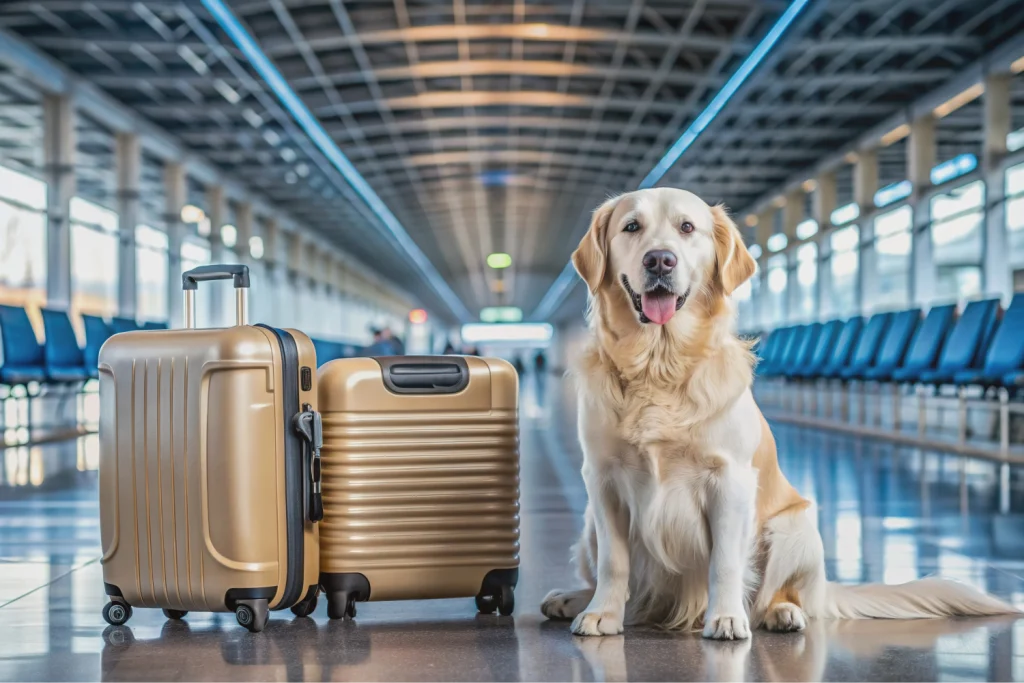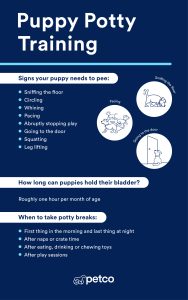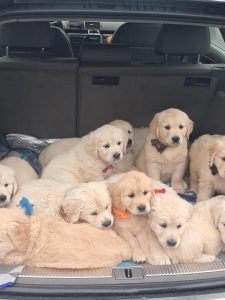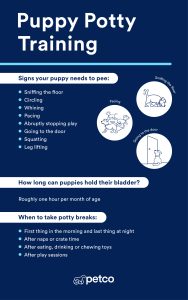Traveling with a large dog on a plane can feel overwhelming. You might be wondering how to keep your furry friend safe and comfortable while navigating airline rules.
What if you don’t know what to pack or how to prepare? This guide will walk you through everything you need to know to make your trip smooth and stress-free. By the end, you’ll feel confident and ready to take off with your loyal companion by your side.
Keep reading—you and your dog deserve a great travel experience.

Credit: www.reddit.com
Choosing The Right Airline
Traveling with a large dog on a plane needs careful planning. Picking the right airline helps make the trip easier.
Each airline has different rules and services for pets. Learning these rules helps avoid problems at the airport.
Pet Policies And Restrictions
Airlines set limits on pet size and breed. Some airlines allow large dogs only in the cargo hold. Others may have weight limits or require special carriers.
Check if your dog’s breed is allowed. Some airlines restrict certain breeds for safety reasons. Knowing these rules helps you pick an airline that fits your dog’s needs.
- Size and weight limits for pets
- Breed restrictions and bans
- Carrier requirements and types allowed
- Whether pets can travel in cabin or cargo
Booking In Advance
Book your pet’s flight as early as possible. Airlines often limit the number of pets per flight. Early booking helps secure a spot for your dog.
Some airlines need you to call to reserve a pet space. Online booking may not always show availability for large dogs. Confirm the reservation directly with the airline.
- Reserve pet space early
- Confirm booking by phone if needed
- Check required documents before booking
- Ask about check-in time for pets
Fees And Charges
Airlines charge fees for traveling with pets. Fees vary by airline and travel method. Cargo travel usually costs more than cabin travel.
Some airlines charge a flat fee. Others charge by weight or distance. Know all fees before booking to avoid surprises at the airport.
| Fee Type | Details |
|---|---|
| Cabin Pet Fee | Fee for pets traveling in the cabin with you |
| Cargo Pet Fee | Fee for pets traveling in the cargo hold |
| Carrier Fee | Extra fee if carrier size exceeds limits |
| Additional Charges | Charges for special handling or paperwork |
Preparing Your Dog For Travel
Traveling with a large dog on a plane needs careful planning. Your dog’s comfort and safety come first.
Prepare your dog before the trip to reduce stress and avoid problems during the flight.
Health Check And Vaccinations
Visit your vet at least a month before the trip. Make sure your dog is healthy and fit for air travel.
- Get a full health checkup to spot any problems.
- Update all required vaccinations for airline rules.
- Ask the vet for a health certificate if needed.
- Discuss any medications that might help your dog stay calm.
Familiarizing With The Carrier
Help your dog get used to the carrier before the flight. This reduces fear and anxiety.
| Action | Purpose |
| Place the carrier in a quiet room | Let your dog explore it at ease |
| Put favorite toys inside | Make the carrier inviting and fun |
| Feed your dog near and inside the carrier | Build positive association with the carrier |
| Practice short stays inside the carrier | Help your dog get comfortable gradually |
Exercise And Feeding Schedule
Plan your dog’s exercise and feeding times carefully before the flight. This helps avoid discomfort.
- Give your dog enough exercise a few hours before travel.
- Feed your dog a light meal 3 to 4 hours before the flight.
- Avoid feeding right before travel to prevent nausea.
- Offer water until one hour before the flight to stay hydrated.
- Keep treats handy for calming your dog during waiting times.
Selecting The Perfect Carrier
Traveling with a large dog on a plane needs careful planning. Choosing the right carrier makes the trip safe and comfortable.
Not all carriers fit airline rules or meet your dog’s needs. This guide helps you pick the best one.
Size And Comfort
Your dog needs enough space to stand, turn, and lie down comfortably inside the carrier. Too small causes stress, too big may not fit under the seat.
- Measure your dog’s length and height carefully.
- Choose a carrier with extra room for movement.
- Look for soft, cushioned floors inside the carrier.
- Check if the carrier has padded sides for comfort.
- Pick a design that is easy to carry and light.
Airline Approved Carriers
Each airline has specific carrier rules. Check their website before buying. Common rules include size limits and material types.
| Airline | Max Carrier Size | Material Allowed |
| Delta | 18 x 11 x 11 inches | Soft-sided |
| United | 19 x 13 x 9 inches | Soft or hard |
| American Airlines | 18 x 11 x 11 inches | Soft-sided |
| Southwest | 18.5 x 16 x 8.5 inches | Soft-sided |
Ventilation And Safety Features
Good airflow keeps your dog cool and calm. Safety features protect your dog during the flight.
- Look for mesh panels on several sides for air.
- Check that zippers and locks are secure.
- Choose carriers with sturdy frames to avoid collapse.
- Pick carriers with leak-proof bottoms to protect luggage.
- Find models with handles and shoulder straps for easy carry.

Credit: greensafaris.com
Day Of The Flight Tips
Traveling with a large dog on a plane can be a challenge. Proper planning makes the journey smoother and stress-free.
These tips will help you and your furry friend have a pleasant flight day experience.
Arriving Early
Arriving early at the airport is important. It gives you extra time for check-in and security checks.
Airports can be busy and unpredictable. Arriving early reduces stress for both you and your dog.
- Arrive at least two hours before your flight
- Allow time for unexpected delays
- Find a quiet spot to relax
Calming Techniques
Calming your dog during the flight is essential. A relaxed dog travels better.
Use calming techniques to keep your dog comfortable. This can help them feel safe and secure.
- Bring a favorite toy or blanket
- Use a calming vest or wrap
- Play soothing music or sounds
Managing Bathroom Breaks
Bathroom breaks are important for your dog. Plan ahead to manage their needs.
Most airports have pet relief areas. Use these spots before and after your flight.
- Locate pet relief areas in advance
- Bring waste bags for cleanup
- Offer water to your dog after breaks
In-flight Considerations
Traveling with a large dog on a plane requires special care. You must prepare for your dog’s comfort and safety during the flight.
Understanding in-flight needs helps reduce stress for both you and your dog. Plan ahead to keep your dog calm and safe in the cabin or cargo hold.
Keeping Your Dog Calm
Large dogs can get anxious on planes. Keep your dog calm by bringing familiar items like a favorite blanket or toy.
Speak softly and offer gentle petting if allowed. Avoid loud noises and sudden movements to prevent stress.
- Bring a familiar blanket or toy
- Speak softly and calmly
- Keep your dog close when possible
- Use calming sprays or treats if recommended
Hydration And Snacks
Keep your dog hydrated by offering water before and after the flight. Avoid giving too much water during the flight to prevent accidents.
Light snacks can help maintain energy. Choose easy-to-digest treats and avoid heavy meals before the flight.
- Offer water before and after the flight
- Bring a spill-proof water bowl
- Give light snacks during long flights
- Avoid heavy meals before traveling
Handling Emergencies
Prepare for emergencies by knowing the airline’s pet policies. Carry your dog’s health records and emergency contact information.
If your dog shows signs of distress, alert the flight crew immediately. Have a plan for quick access to your dog if needed.
- Carry health and vaccination records
- Know the airline’s pet emergency policies
- Alert crew if your dog is in distress
- Keep emergency contacts handy

Credit: www.reddit.com
Post-flight Care
Traveling with a large dog on a plane can be tiring for your pet. After the flight, it is important to care for your dog properly. This helps your dog feel safe and recover quickly.
Post-flight care focuses on helping your dog settle in, watching for health issues, and adjusting to the new place. These steps make the transition smoother for your dog.
Settling In After Arrival
Once you arrive, give your dog time to relax. Find a quiet spot where your dog can rest without noise or distractions. Keep your dog close to you to provide comfort.
Offer water and a light meal if your dog seems hungry. Avoid too much activity right after the flight to prevent stress or injury.
Monitoring Health
Watch your dog for signs of stress or illness after flying. Check for heavy panting, vomiting, or unusual behavior. These may show that your dog is not feeling well.
If you notice any problems, contact a veterinarian quickly. Keep your dog’s travel papers and health records handy in case of an emergency.
- Look for signs of dehydration
- Check breathing and heart rate
- Note any changes in appetite or energy
- Observe for signs of pain or discomfort
Adjusting To New Environments
Help your dog get used to the new place slowly. Keep routines similar to home, like feeding and walking times. This helps your dog feel secure.
Introduce your dog to new sounds and smells one step at a time. Give plenty of praise and treats to encourage positive feelings about the new environment.
- Keep familiar items nearby, like toys or blankets
- Take short walks to explore the area
- Provide a quiet space for rest
- Be patient and calm during the adjustment period
Frequently Asked Questions
Can Large Dogs Travel In The Airplane Cabin?
Most airlines do not allow large dogs in the cabin. Large dogs usually must travel in the cargo hold. Check specific airline policies before booking to confirm size and weight restrictions.
How Do I Prepare My Large Dog For A Flight?
Get your dog used to the travel crate beforehand. Exercise your dog before the flight to reduce anxiety. Bring familiar items like toys and blankets to comfort your pet.
What Are The Airline Requirements For Large Dog Travel?
Airlines require an airline-approved crate that fits your dog comfortably. Health certificates and vaccination records are often mandatory. Booking in advance is essential as space is limited for pets.
Is It Safe For Large Dogs To Fly In Cargo?
Flying in cargo is generally safe when proper precautions are taken. Use a sturdy, well-ventilated crate and avoid extreme weather conditions. Inform the airline about your dog’s needs for added safety.
Conclusion
Traveling with a large dog on a plane takes planning. Choose the right airline and check their pet rules first. Bring your dog’s favorite toys and comfort items. Stay calm and patient during the journey. Preparing well helps your dog feel safe and relaxed.
Enjoy your trip together, making good memories along the way. Safe travel makes the experience better for both of you.

Emily Barker is the founder of ChillDogLife.com, a space dedicated to helping pup parents discover the best dog products, lifestyle tips, and cozy ideas for happier homes.
A lifelong dog lover, Emily combines her passion for pets with a knack for research to share trusted recommendations on everything from toys and furniture to health and everyday care.
Her goal is simple: to make life easier, stylish, and more joyful for dogs and the people who love them.







